
![[ISCEV logo]](../../images/logo74.gif)
| WWW.ISCEV.ORG | Standards | Links |  |
![[ISCEV logo]](../../images/logo74.gif) |
|||
| Events | Books & Archive | Misc | |||||
| Newsletters | Members | About |
|
Address of the ISCEV website:
This newsletter is simultaneously published on the web and on paper, first distributed to the participants of the Leuven Symposium.
To improve future newsletters, send nice and thoughtful feedback to
Michael Bach, |
| President’s Message | top ↑ | ||
| |||
| Secretary-General’s Message | top ↑ | ||
|
|||
| ISCEV Treasurer’s Report: 01 Jan 2001 - 31 Dec 2001 | top ↑ | |||||||||||||||||||||||||||||
|
||||||||||||||||||||||||||||||
| Eimiko Adachi, ISCEV Treasurer | ||||||||||||||||||||||||||||||
| Elections | top ↑ | |
|
The results of the elections in 2001 are as follows: |
Secretary (Asia/Australia): Atsushi Mizota Member-at-Large: Mitch Brigell |
2004 Symposium location: Puerto Rico |
| Minutes of the membership meeting in Manoir des Sables, Montréal, Québec, Canada | top ↑ | ||||
|
1. Opening by the President The meeting is opened at 10.45 by the President, Professor Miyake. 91 members are present. 2. Minutes of the 2000 meeting The minutes of the 2000 Membership Meeting are accepted as a true record and signed as such by the President. There are no matters arising. 3. Report of the Secretary-General The Secretary-General (Professor Barber) presents his report for 2000, which has been published in the Newsletter. There are no matters arising from it. 4. Report of the Treasurer The Treasurer (Professor Adachi) presents her report for 2000, which has been published in the Newsletter. There are no matters arising from it. The President explains that Adachi now wishes to stand down as Treasurer, having completed the period of office remaining when Miyake was elected as President. He thanks her for her valuable work during this period. He informs the meeting that Kellner has been appointed by the Board to act as Treasurer, and this action is confirmed by unanimous vote of the members present. 5. Report of the Editor The Editor (Dr Odom) gives his annual report, which has been published
in the Newsletter. He asks that members note that manuscripts should now
be sent directly to him and not to the publisher Kluwer. 6. Publication Contract for Documenta Ophthalmologica The Secretary-General (Colin Barber) reports that the contract with Kluwer
will be automatically extended for 4 years unless ISCEV gives notice otherwise
before 27 July 2001. In view of a number of problems, the Board does not
wish the contract to be renewed as-is and he has been instructed to renegotiate
the contract with Kluwer. He asks for comments from the floor on this
important issue, commenting that, although the problems are severe, he
believes that Kluwer, in the person of Paul Schuddeboom, who has come
to the symposium, is making a determined effort to put things right. 7. Elections The President announces that elections are needed for the following Board positions: 7.1 Secretary (Asia/Australia) Position vacated by Oguchi The President (Yozo Miyake) presents the Board’s candidate, Dr Atsushi Mizota, and asks if there are further nominations from the floor. Phil Anderton proposes Vaegan. In the absence of the two candidates, the meeting approves by the majority of > 50% each of these candidates, and so Mizota and Vaegan will go forward to a mail ballot of all members eligible to vote. 7.2 Secretary (Americas) Position vacated by Dick Weleber who is eligible for re-election, having served one term. Yozo Miyake presents Weleber as the Board’s candidate, and asks if there are further nominations from the floor. There are none. In the absence of the candidate, the meeting votes. Weleber is elected unanimously. 7.3 Editor Position vacated by Odom, who is eligible for re-election, having served one term. Yozo Miyake presents J Vernon Odom as the Board’s candidate, and asks if there are further nominations from the floor. There are none. In the absence of the candidate, the meeting votes. Odom is elected unanimously. 7.4 Member-at-Large The Secretary-General explains that under the change to the Bye-laws approved last year, this is a new position and there are no geographical constraints. He asks for nominations from the floor. Bill Dawson proposes Mitch Brigrell; Mike Marmor proposes Patrizia Tormene. Both indicate their willingness to stand. In the absence of the two candidates, the meeting approves by the majority of > 50% each of these candidates, and so Brigell and Tormene will go forward to a mail ballot of all members eligible to vote. 8. Future Symposia 8.1 Symposium 2002 Werner Spileers, the organiser, makes a presentation, informing the Meeting about the dates and topics (published in the Newsletter) and giving information about Leuven itself. 8.2 Symposium 2003 Yozo Miyake reminds the meeting that this symposium will be in Nagoya,
Japan. The dates are 6-10 April, when it is hoped the sakura will be in
bloom. The topics are: 8.3 Symposium 2004 Presentations are made at the Membership Meeting by Bill Dawson (Puerto Rica), Anne Fulton (Boston) and Mitch Brigell (Ann Arbor), followed by voting (by show of hands) in the absence of the putative hosts. The outcome of the voting is that Puerto Rica and Boston will go forward to a mail ballot of all members eligible to vote. 8.4 Symposium 2005 The Secretary-General (Colin Barber) reminds the membership that invitations have been received from Egypt(Wahiga Massoud/Azza Shihab) and Glasgow (Daphne McCulloch et al). Post meeting note: he apologises that he forgot to mention an invitation from Berlin (Ulrich Kellner) 9. Standards 9.1 Multifocal Guidelines Mike Marmor describes the progress made since last year and proposes that the final draft, achieved at the working breakfast be approved for publication. This is agreed by a large majority. 9.2 VEP Standard Vernon Odom informs the membership of the meetings held during the course of the symposium and says that the revisions suggested will be publicised on the website for further consultation. Anne Fulton asks that a section be added on paediatric aspects. 9.3 Calibration Guidelines Mitch Brigell describes the progress made at the working breakfast and informs the meeting that consideration is to be given to splitting the document into two: one on “Calibration” and the other on “Good Technical Practice”. 10. Report of the Symposium Organiser
11. Items from the Board Meeting The board appointed Dr Marmor as “Director of Standards” to harmonise the various on-going standardisation groups. Any Other Business Michael Bach makes his usual appeal for people to inform him of their
correct email addresses. There is general acclamation from the floor for the outstanding success of CEVnet and Scott is thanked by the meeting for his hard work and initiative in getting it up and running. Graham Holder, the incoming Director of Education, proposes a vote of thanks to Dick Weleber who this year completes his term as Director. The success of the Teaching Course is acknowledged and Dick is thanked by the meeting for his major role in this. 12. Closing of the meeting The meeting is closed at 12.50 Colin Barber |
|||||
| Future Symposia | top ↑ |
2003The XXXXIth ISCEV Symposium will be organised by Y Miyake in Nagoya,
Japan and is scheduled for 1-5 April 2003
2004The XXXXIIth ISCEV Symposium will take place in Puerto Rico, organised by WW Dawson and is scheduled for 14-18 November 2004
2005We have three invitations for the 2005 symposium: To Cairo/Egypt from Wahiga Massoud & Azza Shihab, to Glasgow/UK by Daphne McCulloch et al., and to Berlin/Germany by Ulrich Kellner. |
|
| Regional reports | top ↑ | ||||||
|
ASIA-AUSTRALIA
EUROPE
|
|||||||
| ISCEV Standard Revisions | top ↑ |
| From the Director of Standards | |
|
The promulgation of guidelines and standards for clinical electrophysiologic testing has become a major function of our ISCEV society beyond our internal affairs. At present we have standards in place for the ERG, EOG, PERG and VEP, and guidelines for mfERG and for the calibration of test equipment. These standards have been highly successful, by creating a core of clinical data that is evaluable for research and clinical care world-wide, and by helping new electrophysiolgists to learn proper basic techniques. At the same time, these standards and guidelines do not limit the scope of electrophysiologic testing in individual laboratories, nor should they stifle exploration of newer or better protocols. For standards to be meaningful, in fact, we need continued evolution to improve upon existing techniques, to add new test protocols, and to eliminate tests that are no longer critical or necessary. We also need to monitor the quality and tone of our documents so that they send a consistent message. |
Current activities: ISCEV has just published “guidelines” for the mfERG, since this is a relatively new procedure and is not ready yet for formal standardization. The revised Calibration Guidelines have recently been submitted to the generaly membership for review. The VEP standard is undergoing its quadrennial re-evaluation, and is also being reviewed to bring it closer in style and focus to the ERG and EOG standards. Finally, some members have proposed the creation of standards for pediatric testing, and for some of the major groups of experimental animals. These proposals are open for discussion, and if appropriate, implementation. I welcome your input on any or all of these issues.
Michael F. Marmor, MD, ISCEV Director of Standards |
| Calibration Guidelines | |
|
I am pleased to inform the ISCEV membership that the Calibration Guidelines revision is in final draft form and has been posted on the website for review. A breakfast meeting will be held in Leuven and, if all goes well, we will bring a vote for approval to the business meeting. I welcome comments and suggestions prior to the meeting. Mitchell Brigell, PhD, Chair Calibration Guidelines
Committee |
|
| ISCEV Editor’s Report | top ↑ | ||||||||||||||||||||||||||||||||||||||||||||||||||||||||||||||||||||||||||||||||||||||||||||||||||||||
J. Vernon Odom, PhD, jodom@wvu.edu,
Editor Documenta Ophthalmologica |
|||||||||||||||||||||||||||||||||||||||||||||||||||||||||||||||||||||||||||||||||||||||||||||||||||||||
| EBERHARD DODT AWARD 2001 | top ↑ | ||
|
|
|||
| Recollections of a Conference | top ↑ | ||
|
|
|||
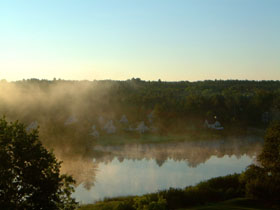 Morning mist on Lake Ormond, beautiful backdrop for the Symposium |
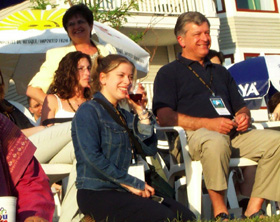 Quite relaxed, organiser Pierre Lachapelle and daughter Julie let the events unfold themselves |
||
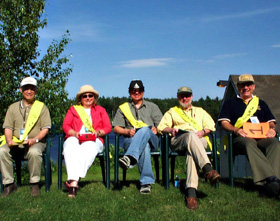 Would you buy a used car from these referees? |
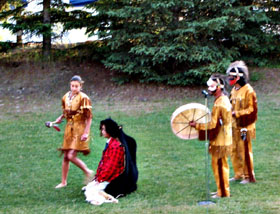 Our illustrious president pow-powing with the natives as an introduction to the festivities |
||
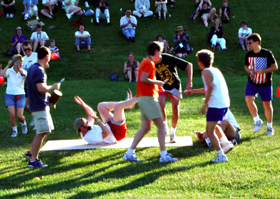 The American team obviously tries hard– |
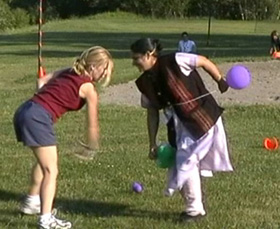 The finalists in the “balloon crushing” competition: Mélanie Lalonde and Subhadra Jalali (picture by Malcolm Brown) |
||
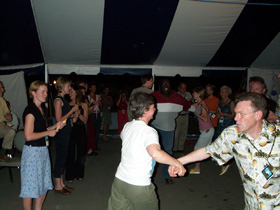 The dances– |
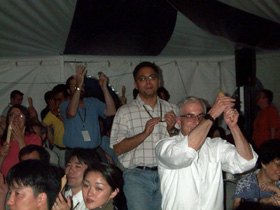 –joined nations. |
||
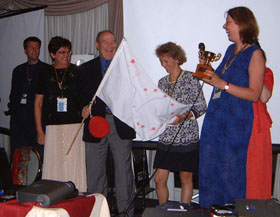 The ISCEV Olympics winning team: Europe (excluding small offshore islands) |
Photos and commentary by Michael Bach. |
||
| Education Director’s Report | top ↑ | ||||||||
|
|||||||||
| Web News | top ↑ |
|
CEVnet, the on-line discussion list-server sponsored by ISCEV, completed its first year of operation in January 2002. The list moderator, Scott E Brodie, wrote: Many thanks to those who participated in this new forum. Overall, in the past year, traffic on CEVnet ran at the rate of approximately one message per day, creating about 70 ‘threads’ of linked discussion topics and responses. I am working on creating a ‘digest’ of the entire first year’s CEVnet traffic, which will allow participants to review old messages on a central server and allow everyone the opportunity to free up disk space on their personal computer without losing access to our prior discussions. We are also planning to provide a summary of CEVnet highlights for the year in Documenta, the ISCEV journal. Please make every effort to keep your email address on our master list up to date. CEVnet users are frequently annoyed by “failure to deliver” messages sent by member’s email servers due to changes in their email address. In order to minimise this problem, I am now actively deleting from the CEVnet address list those addresses which repeatedly reject CEVnet messages. |
Please email any changes of email address to Scott Brodie, CEVnet Moderator, at scott.brodie@mssm.edu (with a Cc to michael.bach@uni-freiburg.de) as well as requests to be added or dropped from the CEVnet list. Remember that the server will accept messages only from active email addresses – if you (or your email server) change your email address, but continue to receive CEVnet messages through an automatic forwarding arrangement, you will not be able to post CEVnet messages until your email listing is updated. Those ISCEV members who were reluctant to participate in CEVnet for fear of overwhelming their email in-box should be reassured that our experience in 2001 indicates that this need not be of concern, and are warmly invited to reconsider!
Scott E. Brodie, MD, PhD; Moderator, CEVnet; scott.brodie@mssm.edu |
|
Our ISCEV website is operative since 1996. In 1999 we acquired the internet domain <www.ISCEV.org>. One of the more importat tidbits there is direct online access to the ISCEV standards. Our website also sports a list with the members’ email addresses, and homepages, if known. As every year, I pledge your help in checking your (and your colleagues) entries there, since we still are missing some, and also get a sizable number of address errors when sending ISCEV information to all members via email. However, an aspect that deserves our attention
here is privacy of sensitive data. We obviously need to balance accessibility
with privacy. When I originally set up the “Members” page I
purposely left out the mail addresses, but added the emails. Over the
last 6 years email spam has risen to exorbitantly. |
The possibility exists that addresses have been picked up by “robots” from our member page. The first step I have taken is to replace the @-sign by a decimal HTML equivalent throughout the member’s page: It ‘looks’ the same, still works with respect to “double-clickability”, but is not recognised as an email address by the dumber robots. We will further provide the choice to “opt out” of having one’s email published on the ISCEV web pages. Any further suggestions here are welcome. My goal for our website is to provide a site with more content than glitz, loading rapidly, scalable to all screen sizes, and not relying on fancy features of the most recent browser version. Please check it out; I welcome your critique. Michael Bach, PhD, Director of International Communication |
| Obituary: Tony Kriss | top ↑ |
|
After a childhood in Peru, Tony arrived for senior school in Scotland a fluent Spanish speaker, with a competitive taste for ball games and an incredible ability to get on with people. He read Psychology at Aberdeen University, where he met his wife Janet. The following year in 1970 Tony did a Masters degree in the Applied Psychology Unit, at Aston University, Birmingham where he became acquainted with electrophysiological techniques, and Graham Harding’s work. Tony was working as a neurophysiologist at the Brook Hospital in London during this time. Tony pursued his interests by continuing with a PhD registered at Aston on the effects of unilateral electro convulsive therapy and took a post as a research scientist in the MRC Unit, led by Martin Halliday at the National Hospital for Nervous diseases, Queen’s Square, London. Tony also spent some time as a Guest Scientist at The Netherlands Ophthalmic Institute, Amsterdam. Although Tony was experienced in all aspects of neurophysiology his interest in visual electrophysiology was kindled and in 1986, in collaboration with David Taylor, Tony established the Visual Electrophysiology Unit at Great Ormond Street Hospital for Children, London. Over the last 15 years Tony sought techniques and methods that allowed visual electrophysiological tests to be applied in infants and children with the minimum of distress and risk; avoiding sedation and anaesthesia. The humanity of his methods and meaningfulness of his results ensured that the demands for his unit’s clinical services increased steadily. In the last 2 years Tony was instrumental in commissioning and designing clinical laboratories and equipment to meet these increasing demands. With Tony’s consent we were proud to name the new expanded clinical facilities at Great Ormond Street after him. Tony was an active member of ISCEV and The British Society of Clinical Neurophysiology. He was actively promoting the close association of academic research and clinical electrophysiology in the role of Clinical Scientist in the UK system. He organised and participated on British Council Courses and held an Associated Links in Science (ALIS) fellowship, sponsored by the British Council and the Slovene government collaborating closely with Jelka Brecelj, in Ljubljana. He had visited many famous international visual electrophysiology laboratories when he first set up the unit at Great Ormond Street and continued to travel widely, lecturing and helping establish units for children across the world. During all this clinical activity Tony enjoyed considerable academic
success with over 100 original papers, numerous chapters and considerable
grant monies. He was intellectually active until his last days at home,
finishing an invited chapter and preparing his PhD student for success
in her viva: his meticulous attention to detail undiminished. Tony’s
early sporting enthusiasm and prowess became a local legend as a succession
of medical residents passing through our department attempted in vain
to beat him on the squash court. Tony helped many of these same residents
develop a taste for research and supervised much of their work. Those of us who had the privilege of working alongside Tony gained so much from his example and experience, and will greatly miss his humanity, humour, and warmth. Tony was dedicated to his family, and our thoughts are with his wife Janet and four children Shona, Isla, Heather and Andrew. Dorothy Thompson. |
|
| WWW.ISCEV.ORG | Standards | Links | ISCEV | ![[ISCEV logo]](../../images/logo74.gif) |
||||
| Symposia | Courses | About | |
|||||
| Newsletter | Members | Misc |
PresidentY Miyake (2003/1)
Secretary-GeneralColin Barber (2004)
Vice-presidentsWW Dawson (Americas, 2002/1)
Secretary for the AmericasRG Weleber (2005/2)
Secretary for Asia and AustraliaA Mizota (2005/1)
|
TreasurerU Kellner (2005/1)
EditorJV Odom (2005/2)
Members-at-largeM Bach (2004/2, Director of International Communication)
Advisory Board MemberM Marmor (2003, Director of Standards)
HONORARY MEMBERS
|